Key takeaways:
- Healthy eating involves a personal balance of variety and nourishment influenced by cultural and emotional factors.
- Mindful eating enhances awareness of hunger cues, appreciation for food, and reduces stress around food choices.
- Meal prepping effectively requires planning, batch cooking, and organizing ingredients to create nutritious meals easily.
- Incorporating mindfulness into meals through appreciation, distraction-free dining, and gratitude enriches the eating experience.

Healthy eating defined
Healthy eating is more than just a choice; it’s a lifestyle, and it often involves a conscious effort to nourish our bodies with beneficial foods. When I think about healthy eating, I remember the first time I made a green smoothie—it was a game changer. The vibrant colors and fresh flavors made me realize that healthy foods can be both delicious and satisfying.
I’ve often found myself asking, “What does it really mean to eat healthily?” For me, it revolves around balance and variety. I can vividly recall my struggle with meal planning; it felt overwhelming at first. But when I started incorporating different fruits, vegetables, whole grains, and lean proteins into my meals, I noticed not just physical changes, but a shift in my overall energy and mood.
Healthy eating is deeply personal and often influenced by our emotional and cultural backgrounds. I once chatted with a friend who grew up in a family that valued home-cooked meals, and she shared how that shaped her dietary habits. It made me consider how our upbringing and experiences can shape our relationship with food, reinforcing the idea that healthy eating is not a one-size-fits-all approach. How do your experiences and upbringing influence your dietary choices? It’s an enriching conversation worth having.
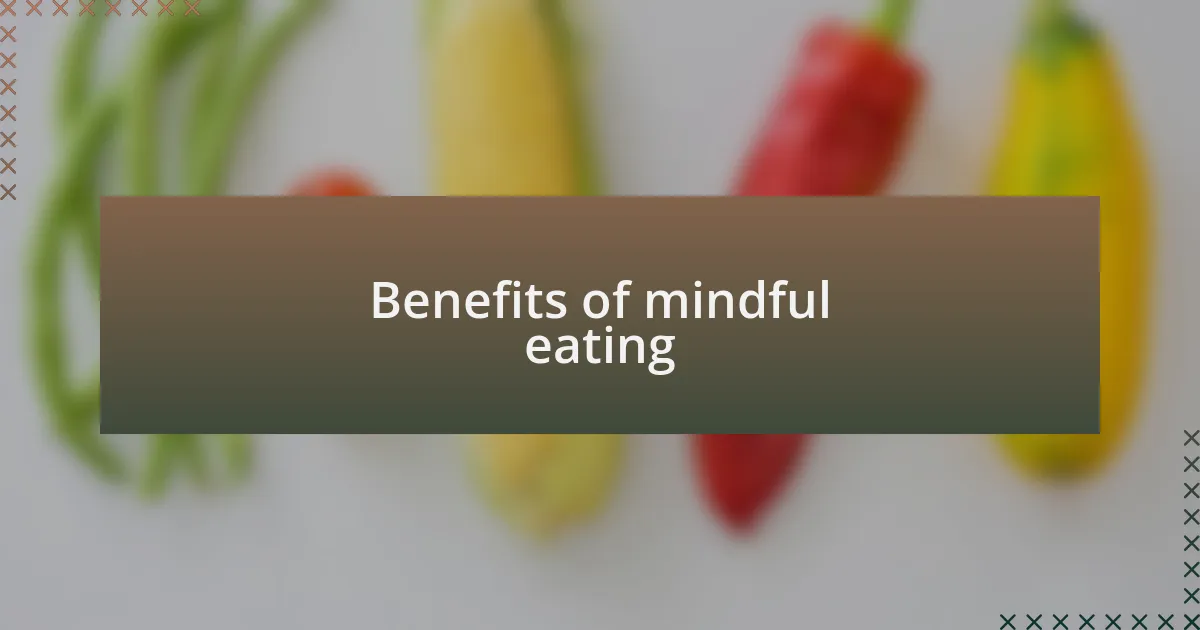
Benefits of mindful eating
Mindful eating offers numerous benefits that extend beyond simply enjoying food. One of the most impactful advantages I’ve experienced is the enhanced ability to listen to my body. I was amazed when I started recognizing when I was truly hungry or just bored. Have you ever noticed how much we eat out of habit rather than necessity? It’s eye-opening.
Another remarkable benefit is the heightened appreciation for flavors and textures. I remember a time when I rushed through meals, barely tasting anything. After practicing mindfulness at the table, I started to notice the subtle sweetness of roasted vegetables or the creaminess of avocado. This shift not only made my meals more enjoyable but also encouraged me to choose healthier options because I was more engaged with what I was eating.
Additionally, mindful eating can significantly reduce stress around food choices. There was a period when I felt pressured by diet trends, constantly second-guessing what I should or shouldn’t eat. Embracing a mindful approach transformed this anxiety into joy. I learned to savor each bite without guilt or pressure. How liberating is it to simply celebrate food without the weight of expectations?
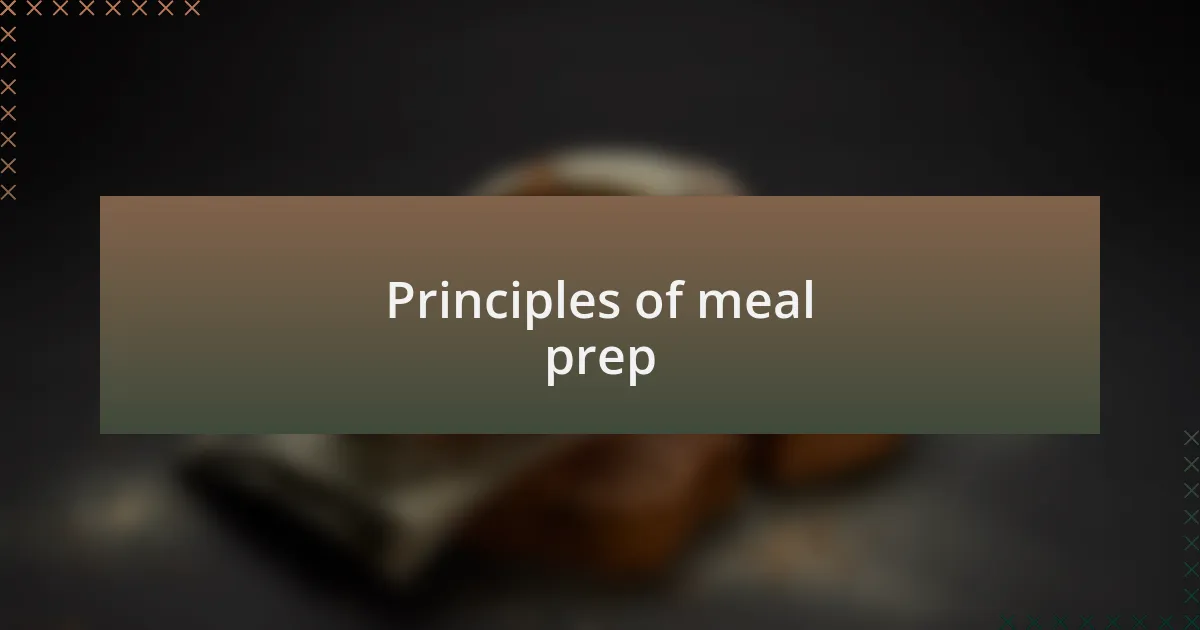
Principles of meal prep
Meal prepping hinges on a few core principles that can transform your approach to eating healthily. One of the most crucial is planning ahead. I can’t stress enough how much easier it is to stick to nutritious choices when I’ve dedicated time to map out my meals for the week. Have you ever found yourself scrambling for something healthy at the last minute? Planning really alleviates that stress.
Another key principle is batch cooking. I frequently make large portions of staples, like quinoa or roasted vegetables, which I can then mix and match throughout the week. This not only saves time but also allows me to enjoy variety without the fuss of daily cooking. Who doesn’t love the idea of a delicious home-cooked meal without the hassle every single day?
Finally, investing in quality containers is a game changer. I remember when I used to use mismatched lids and containers that leaked. It was frustrating! Now, I use clear, airtight containers that not only keep my food fresh but also make it easy to see what I have on hand. This simple switch keeps my meals organized and encourages me to reach for healthy options instead of resorting to takeout. It’s amazing how little adjustments can lead to healthier habits, don’t you think?

Planning your meal prep
When I sit down to plan my meals, I treat it like a creative session. I love to open my fridge and pantry, survey what I have, and think of different combinations. It feels satisfying to transform what’s available into a week’s worth of nutritious meals. Have you ever had that moment of clarity when a few humble ingredients turn into something exciting?
I often find that I can maximize my meal prep efficiency by choosing themes for the week. For instance, dedicating a week to Mediterranean flavors can inspire me to batch cook chickpeas, roasted red peppers, and whole grains. The next thing I know, I have delightful salad bowls and wraps ready to go. Isn’t it fantastic how a little focus can lead to such variety?
Another aspect I cannot overlook is the importance of setting a specific day and time for meal prep. I usually choose Sundays, and the anticipation of a well-organized kitchen fuels my enthusiasm. Using that time means I enter the week without the nagging question of what to eat. I remember the weeks when I skipped this step; suddenly, the healthy choices I intended to make became a distant memory. Planning really does lay the groundwork for success, doesn’t it?
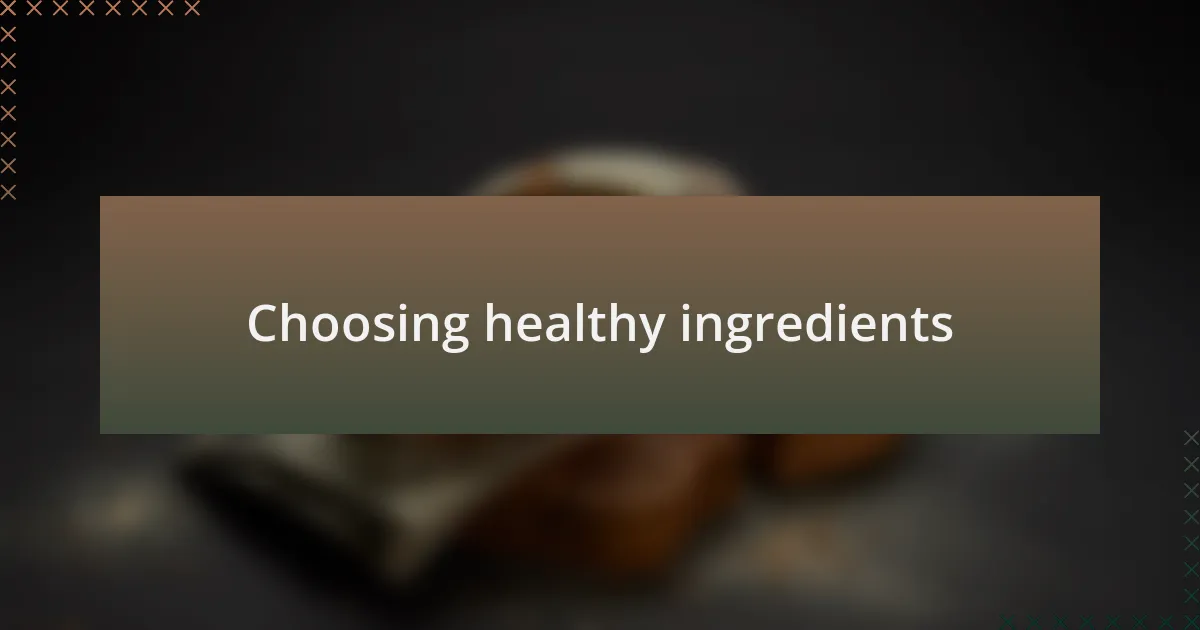
Choosing healthy ingredients
Choosing healthy ingredients can be a game-changer in my meal prep routine. I find that starting with whole, unprocessed foods is key. When I pick fresh vegetables, lean proteins, and whole grains, I not only enhance the nutritional value of my meals, but I also notice a shift in how I feel. Do you ever experience that boost in energy when you eat something wholesome? I certainly do.
I take special care to read labels whenever I buy packaged items. Sometimes, I am startled by the hidden sugars or sodium levels that can sneak their way into food. I remember a time when I bought a seemingly healthy granola, only to discover it was loaded with added sugars. Now, I opt for items with recognizable ingredients, which gives me peace of mind. It feels rewarding to make informed choices—how about you?
When I select fruits and vegetables, I like to choose a rainbow of colors. This isn’t just because they look beautiful; each color often represents different nutrients and antioxidants that benefit my health. A vibrant plate not only tastes better but also feels exciting to eat. I challenge you to experiment with colors in your cooking and see how it impacts both the flavor and your overall mood.
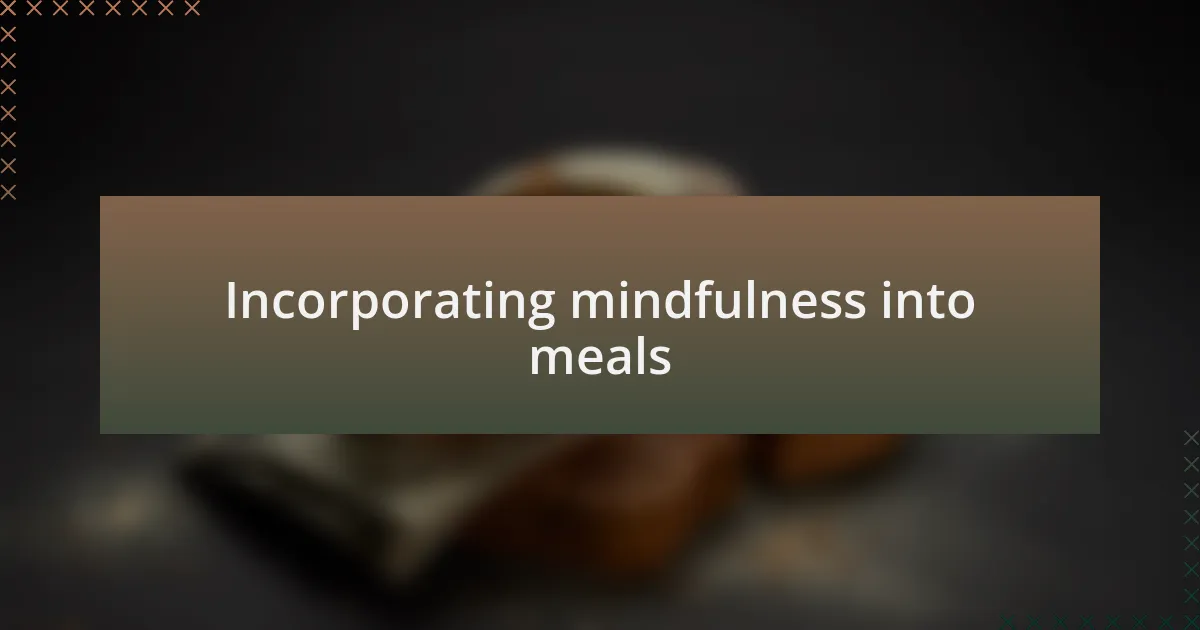
Incorporating mindfulness into meals
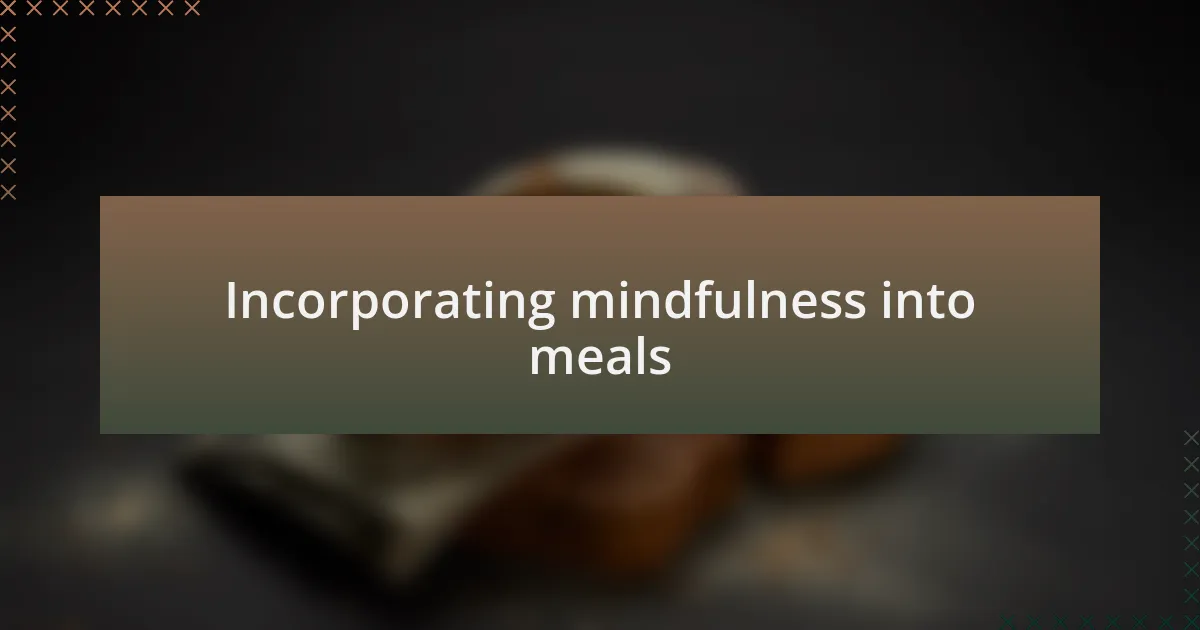
Incorporating mindfulness into meals
One of the ways I weave mindfulness into my meals is by taking a moment to appreciate the aromas and colors before I dig in. Just the other day, I prepared a vibrant salad filled with peppers, carrots, and leafy greens. Taking the time to notice the scents and hues made me feel connected to the food and the efforts behind its preparation. How often do you pause to truly experience your meals? It can change everything.
I also believe in creating a distraction-free zone during mealtime. Ditching the screens and taking a moment to focus on each bite has brought a new level of enjoyment to my meals. I remember when I first tried this approach—I’d always rush through lunches, scarcely tasting anything. Now, savoring each flavor and texture allows me to slow down and really appreciate my food. Have you ever tried mindful eating?
Finally, I like to express gratitude before eating. Taking a moment to acknowledge the hard work that goes into growing and preparing my food transforms my meal into a heartfelt experience. When I share a meal with friends, we often take turns sharing what we appreciate about the meal or ingredients. This simple act fosters a deeper connection with both the food and each other, enriching the overall experience. What small practices do you engage in to make your meals more meaningful?
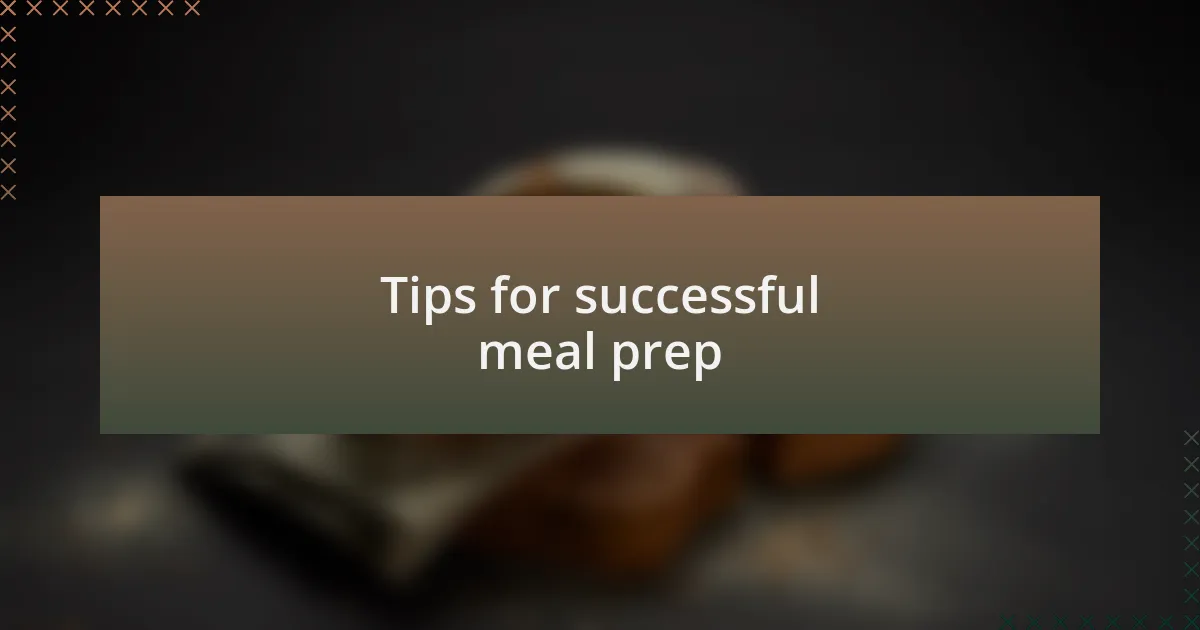
Tips for successful meal prep
When it comes to successful meal prep, organization is key. I’ve found that dedicating a specific day and time for prepping eliminates last-minute stress and uncertainty. For instance, my Sundays are reserved for chopping, marinating, and packaging meals. This routine has not only streamlined my week but also transformed cooking into a meditative practice. Have you thought about making meal prep a ritual in your week?
I also encourage experimenting with different containers. I’ve discovered that using clear glass containers not only keeps food fresh but also allows me to see what I have at a glance. There’s something satisfying about opening my fridge and seeing colorful, neatly packed meals ready to go. Have you noticed how the right presentation can motivate you to reach for healthier options?
Lastly, I recommend prepping versatile ingredients. I often cook a big batch of quinoa or roasted vegetables, which I can use in various dishes throughout the week. This versatility makes it easier to create balanced meals without feeling bored. Just last week, I transformed leftover roasted sweet potatoes into a hearty soup, and it felt rewarding to make the most out of my prep. What’s your go-to ingredient that adds flexibility to your meals?